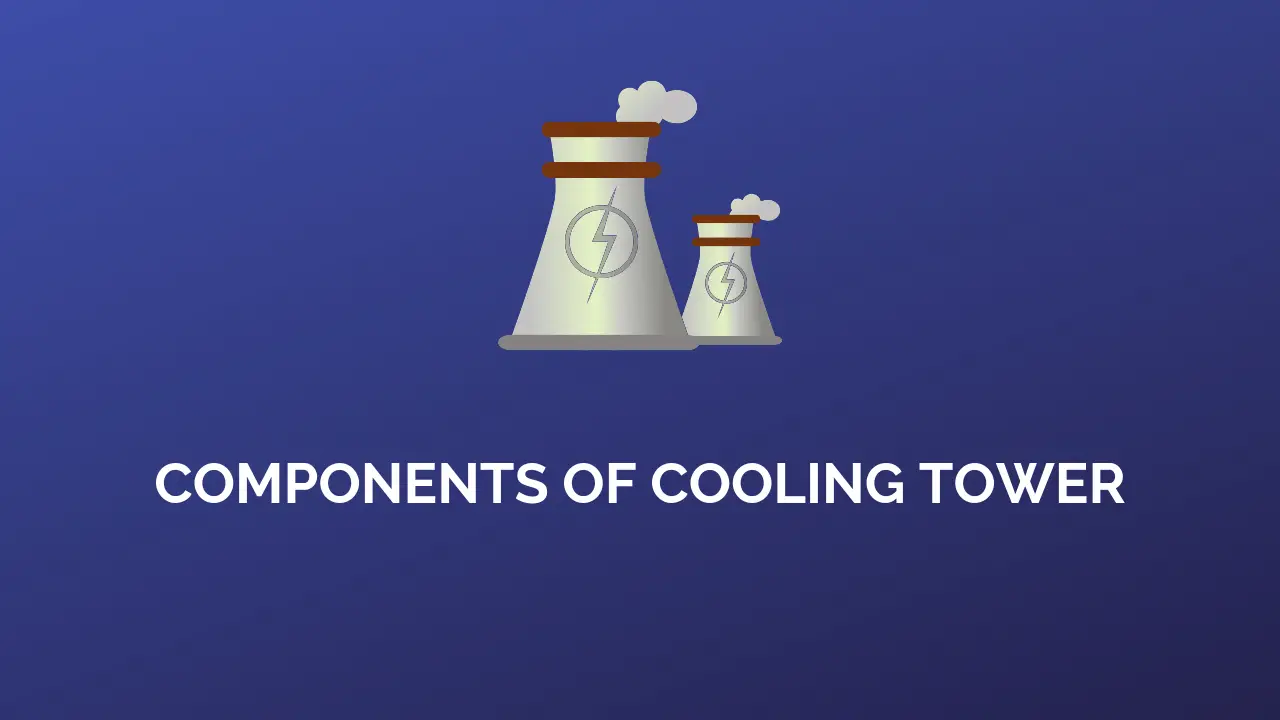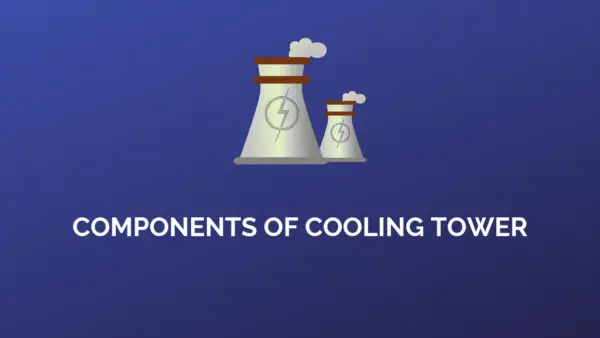The main components of cooling tower are: Frames, fill, nozzles, drift eliminators, fan, air inlet, louvers, cold water basin.
Let us understand the definition & functions of each of them one by one.
Cooling Tower Components:

Frame: Frame is basically a structure of cooling tower that holds all essential components of cooling tower like fan, motors etc.
Fill: Normally, Fills are made of plastic or wood. Fill can either be a splash type or film type.
In splash fill water falls over horizontal layers of splash bars that continuously breaks water into small droplets and also wetting the fill surface. The rate of heat transfer in plastic splash fill is better that wood splash fill.
Film fill consists of thin closely placed plastic surfaces on them water spreads and form a thin film in contact with air. These surfaces may be flat, honeycombed or other patterns. Film fill is more efficient than splash fill.
Nozzles: The function of nozzles is to spray water and wet the fill. Uniform water distribution is essential to achieve proper wetting of entire fill surface. Nozzles can either be fixed in place and have either round or square spray patterns or can be part of a rotating assembly as found in some circular cross-section towers.
Drift Eliminators: It captures water droplets that escape with air from the tower. Otherwise water would be lost to atmosphere. Ultimately drift eliminators save loss of water from cooling tower.
Fans: axial (propeller type) and centrifugal fans are used in towers. Generally, propeller fans are used in induced draft tower while both propeller & centrifugal fans are used in forced draft towers.
Air Inlet: This is the entry point of air into the cooling tower. This entry point may be entire side of a tower (cross section design) or bottom of the tower (counter flow design).
Louvers: The main purpose of the louvers is to equalize the air flow into the fill & retain water into the tower. Generally, cross flow towers has inlet louvers while many counter flow tower designs do not require louvers.
Cold Water Basin: The cold water basin located at near or bottom of the tower. The function of cold water basin is to receive cold water which is flow through the fills. The basin usually has a sump or low point for the cold water discharge connection.
Cooling Tower Material:
Earlier, cooling towers were constructed primarily with wood, including the frame, casing, louvers, fill and cold-water basin. In some cases the cold-water basin was made of concrete.
Today, manufacturers are using a variety of materials to construct cooling towers. Materials are chosen based on properties like enhance corrosion resistance, reduce maintenance, and promote reliability and long service life.
Galvanized steel, various grades of stainless steel, glass fiber, and concrete are commonly used in construction of cooling tower. Aluminum and plastics are also use for some components.
#1. Frame and Casing: You can still found wooden cooling towers, but many components of this tower made from different materials, such as the casing around the wooden framework made of glass fiber, the inlet air louvers of glass fiber, the fill of plastic and the cold-water basin of steel.
Where corrosive atmosphere is an issue galvanized steel is use to construct casings & basins of the tower.
Mostly, larger towers are made of concrete. Glass fiber is also broadly used for cooling tower casings and basins, because they extend the life of the cooling tower by protecting cooling tower from harmful chemicals.
#2. Fill: Plastics are generally used for fill, including PVC, polypropylene, and other polymers. Film fill is the first choice because of its higher heat transfer efficiency where the circulating water is free from debris or contains less suspended solids.
#3. Nozzles: Plastics are commonly used for nozzles. Many nozzles are made of PVC, ABS, polypropylene, and glass-filled nylon.
#4. Fan: Aluminum, glass fiber and galvanized steel are mostly used as fan materials. Centrifugal fans are often made from galvanized steel. Propeller of fans are made from galvanized steel, aluminum or molded glass fiber reinforced plastic.
